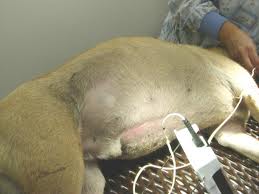The other day a patient came in that had been sick since approximately 6 hours prior to presentation. This patient was weak and had abdominal distension and the owner correctly assumed this dog had what is commonly referred to as bloat.
In essence, this is can actually be two different things:
1. Simple bloat - where the stomach fills up with air, food, water, something else (foreign things the dog ate, etc)
2. GDV - gastric dilatation and volvulus - so the stomach fills up and then flips anywhere from 90-360 degrees. NOT a good thing. This quickly puts the dog in a state of shock as the distended stomach cuts off the vena cava.
We can quickly determine which one it is by a simple radiograph. This is what it looks like when the stomach twists:
This causes all sorts of very serious problems. In essence, there is a critical "golden hour" that is ideal for intervening. The longer this goes on, the more likely that there will be complications and possibly even death. Some complications seen include: necrosis or death of part of or all of the stomach (as blood supply is cut off), engorgement of the spleen necessitating a splenectomy, cardiac arrhythmias and disseminated intravascular coagulation (aka DIC aka Death Is Coming!).
The way to treat to this is to stabilize the patient with IV fluids, steroids and other medications and get them to surgery as quickly as possible. Some people will decompress the stomach before surgery by inserting a needle through the skin and into the stomach (hopefully). Also we can try to pass an orogastric tube BUT if the stomach is twisted it will NOT pass. If it's a simple bloat with no twist, this is a great way to decompress the stomach. Of course this is all done under anesthesia. The dog will fight too much while awake, so while they are NOT great anesthetic candidates, there really is no other choice here for the most efficient, effective way to get the job done.
Once in surgery, the stomach is decompressed with a sterile needle, de-rotated, a stomach tube is then passed to empty out what is left, the entire abdomen is explored, anything that needs to be removed is and the stomach is "tacked" in place to prevent it from twisting again (you cannot do anything to prevent a simple bloat from happening).
What can you do to prevent this? There are cases where owners come home and simply find their animal in this state (with no "cause") or they find the animal dead from this. The risk factors are:
1. Being a large, deep chested breed - German Shepherds, Great Danes, Irish Wolfhounds, Dobermans, Rottweilers - small dogs simply do NOT get this condition
2. Exercise after a large meal or large amount of water
3. Feeding one large meal a day - better to feed 2 or 3 smaller ones
4. Age - there is some indication that with age the ligaments holding the stomach in its proper place get lax and allow for a higher chance of twisting
The dog that came in to us did have about 1/4 of his stomach that was questionable as far as viability. Even after untwisting it, it did not return to a good color. Everything else was ok and he made it through surgery and is still doing well. He's not out of the woods yet, but this is a good sign.



No comments:
Post a Comment